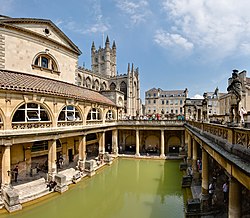Urban baths















Algeria
- Timgad
- Guelma (Calama)
- Héliopolis
- Hammam Meskoutine (Aquae Tibilitanae)
- Hammam Righa (Aquae Calidae)
- Hammam Essalihine (Aquae Flavianae)
Austria
Bulgaria
- Kyustendil (Pautalia)
- Roman Thermae, Varna (Odessus)
- Hisarya (Augusta Diocletianopolis)
- Sozopol
Croatia
- Varaždinske Toplice (Aquae Iasae)
- Daruvar (Aquae Balissae)
- Topusko
France
- Arles – Thermes de Constantin
- Aix-en-Provence (Aquae Sextiae)
- Bagnères-de-Luchon (Onesiorum Thermae of Strabo)
- Cimiez (Cemenelum)
- Glanum, near today's Saint-Rémy-de-Provence
- Lillebonne (Juliobona)
- Metz (Divodurum Mediomatricorum) - Thermes de Metz
- Paris – Thermes de Cluny
- Plombières-les-Bains – Calodae
- Saintes, Charente-Maritime (Mediolanum Santonum)
- Bliesbruck baths
Germany
- Baden-Baden, Baden-Württemberg
- Trier Imperial Baths, Barbara Baths, and Forum Baths in Trier, Germany
- Weißenburg
- Badenweiler Thermae
Hungary
Israel
Jordan
Italy
- Bagnaccio
- Baths at Ostia
- Baths of Agrippa
- Baths of Caracalla
- Terme dell'Indirizzo, Catania
- Baths of Diocletian
- Baths of Hercules
- Baths of Titus
- Baths of Trajan
- Chieti (Teate Marrucinorum), Abruzzo
- Fiesole
- Herculaneum
- Pompeii (ruins)
- Baths of Puteoli
- Terme Taurine
Lebanon
Libya
- Leptis Magna – Hadrian's baths
- Hunting Baths, Leptis Magna
North Macedonia
- Strumica (Tiveriopolis)
Malta
- Għajn Tuffieħa Roman Baths
- Ta' Bista Catacombs and Roman baths
- Xemxija Roman Baths
- Xaghra Ramla l-Hamra Roman Baths (Gozo)
The Netherlands
Portugal
Romania
- Băile Herculane
- Germisara (Geoagiu)
Spain
Tunisia
- Dougga – Bath of the Cyclopses (ruins)
- Dougga – Antonian Bath (ruins)
- Dougga – Aïn Doura Bath (ruins)
- Dougga – Licinian Baths (ruins)
- Gafsa – Roman baths of Gafsa
- Sbeitla – Roman baths of Sbeitla (ruins)
- Tunis (Carthage) – Baths of Antoninus
Turkey
- Ankara – Baths of Ancyra (ruins)
- Muğla – Kaunos
- Yozgat – Basilica Therma
United Kingdom
- Bath – Roman Baths
- Cheapside Baths, in London [2]
- Exeter, Devon
- Huggin Hill Baths, in London [2]
- Leicester – Jewry Wall
- Ribchester, in Lancashire
- Tripontium, near today's Rugby, Warwickshire
- Welwyn, Hertfordshire – Welwyn Roman Baths